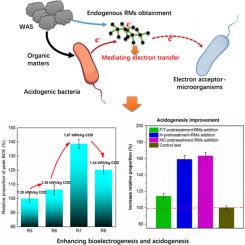Water Research ( IF 11.4 ) Pub Date : 2023-04-12 , DOI: 10.1016/j.watres.2023.119974 Xiaodong Xin 1 , Jiaqian Xie 2 , Yanfang Wang 3 , Lin Li 4 , Wei Li 5 , Sihao Lv 5 , Zhidan Wen 6 , Junguo He 7 , Ying Xin 8

|
Anaerobic biological treatment was regarded as one of promising options for realizing concurrent WAS reduction, stabilization and bioenergy/bioresource recycle. But the relatively low treatment efficiency limited its spreading application toward larger scale considerably in China. Aimed at such barrier, this study offered a novel enhancing strategy for achieving high-efficiency of bioenergy/bioresource recycle from WAS anaerobic treatment via improving bioelectrogenesis/acidogenesis using sludge source-redox mediators (SSRMs). SSRMs not only facilitated bioeletrogenesis with an increasing efficiency of 36% for voltage output and 39% for bioelectricity bioconversion, but also enhanced acidogenesis of WAS with a mean elevating efficiency of 37.5% of volatile fatty acids (VFAs) production within 5 d Mechanistic investigations indicated that SSRMs had a potential influence on improving the protein and carbohydrate metabolisms-related genes’ expression for enhancing bioelectrogenesis and acidogenesis. Moreover, SSRMs exerted roles of electrochemical “catalysts” or as terminal electron acceptors with affecting functional proteins of complexes of Ⅰ and Ⅳ in electron transfer chains for improving electron transfer efficiency. Meanwhile, the core members’ abundance, microbial diversity and community distributive evenness were prompted concurrently for carrying out superior bioelectrogenesis and acidogenesis. A schematic illustration was established for demonstrating the mechanism of SSRMs for enhancing bioelectrogenesis and acidogenesis via changing microbial metabolism functions, enhancing electron transfer efficiency, and regulating functional genes’ expression of functional proteins (up-regulating cytochrome c oxidase and down-regulating-NADH dehydrogenase). This study provided an effective enhancing strategy for facilitating WAS bioconversion to bioenergy/bioresource with well-process sustainability.
中文翻译:

污泥源-氧化还原介质的获得和增强生物电生成和酸生成的可用性:破译特征和机制
厌氧生物处理被认为是同时实现 WAS 减少、稳定和生物能源/生物资源回收的有前途的选择之一。但相对较低的处理效率大大限制了其在我国向更大规模的推广应用。针对这一障碍,本研究提供了一种新的增强策略,通过使用污泥源-氧化还原介质 (SSRM) 改善生物电生成/酸生成,实现 WAS 厌氧处理的生物能源/生物资源的高效循环。SSRM 不仅促进了生物电生成,电压输出效率提高了 36%,生物电生物转化效率提高了 39%,而且还增强了 WAS 的酸生成,平均提高效率为 37。5 天内产生 5% 的挥发性脂肪酸 (VFA) 机理研究表明,SSRM 对改善蛋白质和碳水化合物代谢相关基因的表达以增强生物电生成和酸生成具有潜在影响。此外,SSRMs发挥电化学“催化剂”或末端电子受体的作用,影响电子传递链中复合物Ⅰ和Ⅳ的功能蛋白,从而提高电子传递效率。同时,核心成员的丰度、微生物多样性和群落分布均匀性同时促进了生物产电和产酸的进行。建立了一个示意图来说明 SSRMs 通过改变微生物代谢功能来增强生物电生成和酸生成的机制,提高电子传递效率,调节功能蛋白的功能基因表达(上调细胞色素c氧化酶和下调-NADH脱氢酶)。该研究为促进 WAS 生物转化为具有良好过程可持续性的生物能源/生物资源提供了有效的增强策略。






































 京公网安备 11010802027423号
京公网安备 11010802027423号